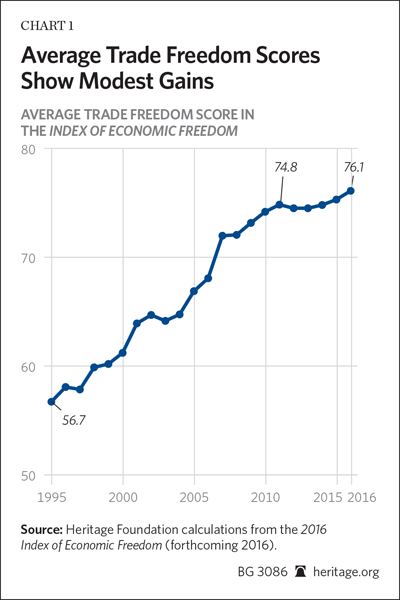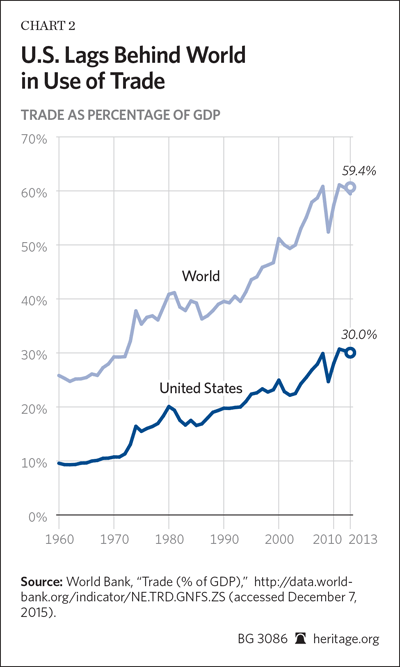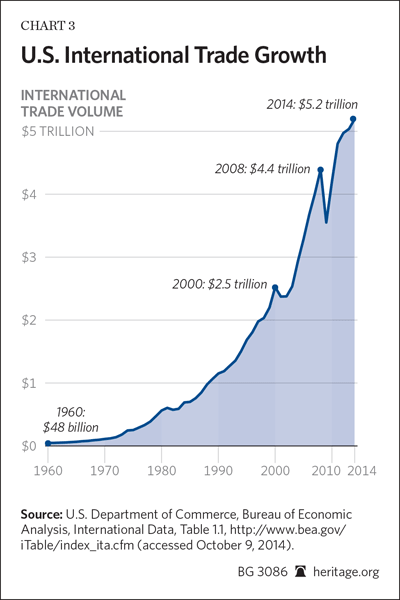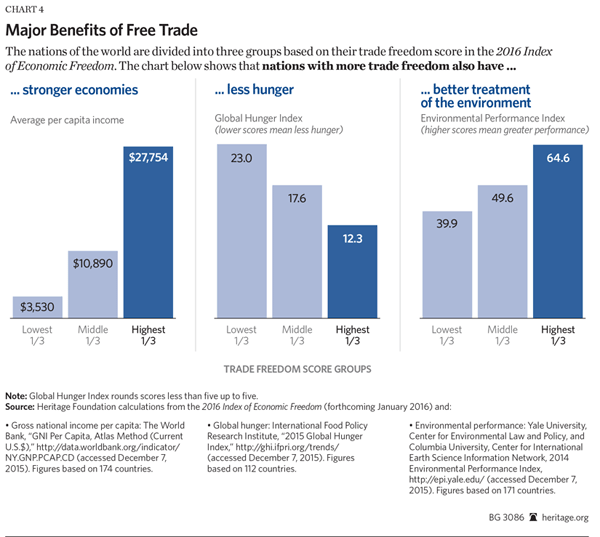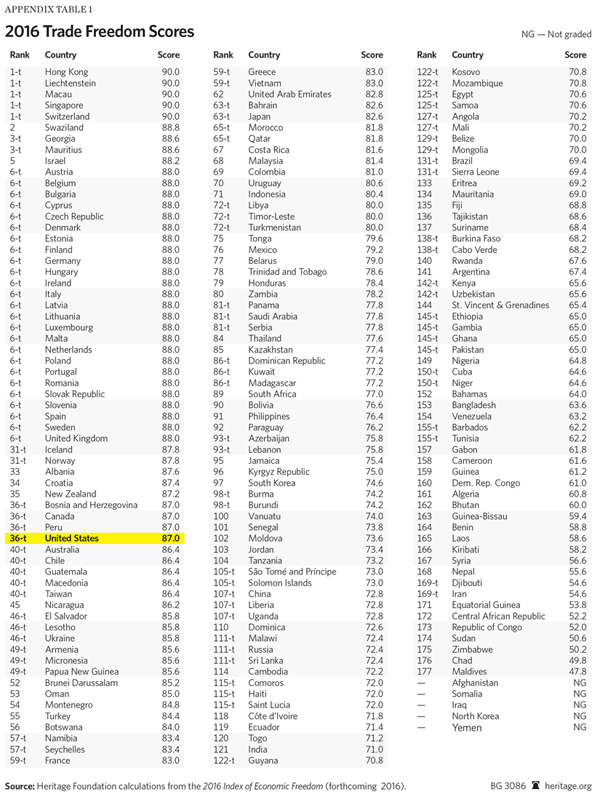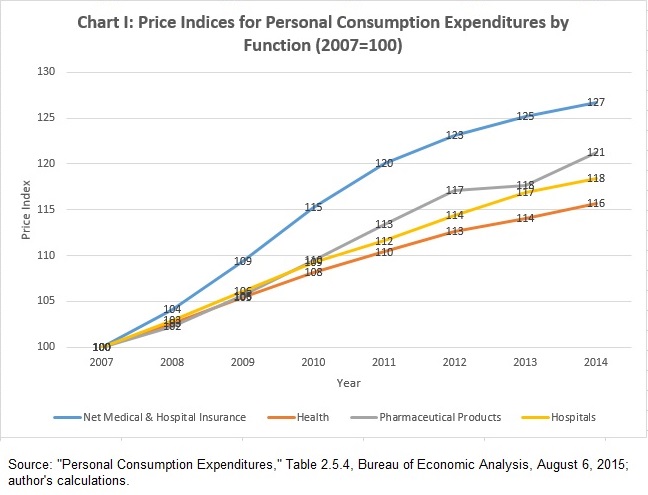By Bryan Riley and Ambassador Terry Miller*
The latest rankings of trade freedom around the world,[1] included by The Heritage Foundation and The Wall Street Journal in the forthcoming 2016 Index of Economic Freedom, confirm that citizens of countries that embrace free trade are better off than those in countries that do not. The data continue to show a strong correlation between trade freedom and a variety of positive indicators, including economic prosperity, low poverty rates, and clean environments.
Worldwide, the average trade freedom score improved slightly, from 75.3 to 75.6 (of a maximum score of 100). The improvement was due to a modest decline in average tariff rates among the countries measured.
![SR-trade-freedom-2016-chart-1]() The volume of world trade in goods and services plummeted during the global recession, declining by nearly 20 percent between 2008 and 2009. Since then, trade volume has increased every year. In dollar terms, world trade volume is currently larger than ever, and the World Trade Organization (WTO) predicts another 3.9 percent increase in global trade in 2016.[2]
The volume of world trade in goods and services plummeted during the global recession, declining by nearly 20 percent between 2008 and 2009. Since then, trade volume has increased every year. In dollar terms, world trade volume is currently larger than ever, and the World Trade Organization (WTO) predicts another 3.9 percent increase in global trade in 2016.[2]
U.S. trade volume has also increased. From 2013 to 2014, combined U.S. exports and imports increased by $156 billion to $5.2 trillion, the highest overall level in history.
Why Trade Freedom Matters
A comparison of economic performance and trade scores in the 2016 Index of Economic Freedom demonstrates the importance of trade freedom for prosperity and well-being. Countries with the most trade freedom have higher per capita incomes, lower rates of hunger in their populations, and cleaner environments.
Boosting Trade and Economic Freedom. Since World War II, government barriers to global commerce have been reduced significantly. Today, the average worldwide tariff rate is less than 3 percent. The average world tariff rate has fallen by one-third since the turn of the century alone.[3] Thirty-eight countries have an average tariff rate of 1 percent or less.
![SR-trade-freedom-2016-chart-2]() These countries with low tariffs and few non-tariff barriers benefit from stronger economic growth. But free trade policies do not just promote economic growth, they encourage freedom—including protection of private property rights and the freedom of average people to buy what they think is best for their families, regardless of attempts by special-interest groups to restrict that freedom.
These countries with low tariffs and few non-tariff barriers benefit from stronger economic growth. But free trade policies do not just promote economic growth, they encourage freedom—including protection of private property rights and the freedom of average people to buy what they think is best for their families, regardless of attempts by special-interest groups to restrict that freedom.
But not all countries have embraced free trade. Double-digit tariff rates are applied in 37 countries, and even countries with low average tariff rates often have high tariff peaks for specific items. In the United States, for example, the average tariff rate is just 1.5 percent, but pickup trucks face a prohibitive 25 percent tariff, and many types of clothing are subject to double-digit tariffs.[4]
Approaches to Trade Freedom. The simplest way to achieve trade freedom is to unilaterally reduce tariff and non-tariff barriers. Reducing trade barriers allows countries to reap benefits including increased foreign investment and accelerated economic growth. Many developing countries have taken this route. Economist Richard Baldwin described unilateral tariff cuts in developing countries beginning in the 1980s as a “curiously universal phenomenon.”[5] These unilateral tariff cuts generated dramatic results. As economist Pierre-Louis Vézina observed, “[T]wo decades of unilateral tariff-cutting in emerging economies accompanied the most successful trade-led development model of the past 50 years, i.e., ‘Factory Asia.’”[6]
![SR-trade-freedom-2016-chart-3]() Reducing barriers to imports allows countries to participate in global value chains by encouraging foreign investment and lowering the cost of inputs. Increasing trade barriers has the opposite result. According to the Organization for Economic Co-operation and Development (OECD), “Protective measures against imports of intermediate products increase the costs of production and reduce a country’s ability to compete in export markets: tariffs and other barriers to imports are effectively a tax on exports.”[7]
Reducing barriers to imports allows countries to participate in global value chains by encouraging foreign investment and lowering the cost of inputs. Increasing trade barriers has the opposite result. According to the Organization for Economic Co-operation and Development (OECD), “Protective measures against imports of intermediate products increase the costs of production and reduce a country’s ability to compete in export markets: tariffs and other barriers to imports are effectively a tax on exports.”[7]
Trade agreements have provided another way to reduce trade barriers. As Douglas A. Irwin observed:
[M]ultilateral reductions in trade barriers may reduce political opposition to free trade in each of the countries involved. That is because groups that otherwise would be opposed or indifferent to trade reform might join the campaign for free trade if they see opportunities for exporting to the other countries in the trade agreement. Consequently, free trade agreements between countries or regions are a useful strategy for liberalizing world trade.[8]
More than 250 regional and bilateral agreements are in force, with dozens more being negotiated.[9]![SR-trade-freedom-2016-chart-4-600]()
Examples of regional and sectoral negotiations include the following:
Continental Free Trade Area for Africa (CFTA). In 2012, the African Union Summit approved a plan to create a continental free trade zone by 2017. According to the Action Plan for Boosting Intra-Africa trade, “Trade is widely accepted as an important engine of economic growth and development. There are many regions and countries of the world that have been able to lift their people from poverty to prosperity through trade. In Africa however, trade has not served as a potent instrument for the achievement of rapid and sustainable economic growth and development.”[10] Potential benefits identified by the African Union include improved food security through reductions in agricultural protectionism, increased competitiveness, and reduced reliance on foreign aid.
Trans-Pacific Partnership (TPP). Current TPP participants are the United States, Australia, Brunei, Canada, Chile, Japan, Malaysia, Mexico, New Zealand, Peru, Singapore, and Vietnam. TPP negotiations were completed in October, and member countries are currently reviewing the final product.
Transatlantic Trade and Investment Partnership (TTIP). Negotiations for this agreement between the United States and the European Union are ongoing. A TTIP agreement that reduces barriers to trade and investment between the United States and the EU, thereby empowering individuals on both continents, would boost trade freedom. To be successful, negotiators need to resist efforts to create new regulatory barriers to trade under the guise of “harmonization.”
Trade in Services Agreement (TISA). Service industries account for nearly 80 percent of the U.S. economy.[11] In 2013, countries representing a majority of the world’s services market launched TISA negotiations, covering industries such as transportation, travel, communications services, construction, insurance, banking, and computer services. Numerous barriers interfere with the free flow of trade in services. For example, state-owned enterprises often restrict competition from foreign companies; many government policies are biased against services provided by foreign companies; local ownership requirements require service providers to partner with local businesses; and data storage requirements force companies to store their data locally.
Information Technology Agreement (ITA). This past July, 54 WTO members agreed to eliminate tariffs on more than 200 products accounting for over $1 trillion in annual trade. Tariffs will be eliminated on products including semi-conductors, GPS navigation systems, magnetic resonance imaging machines, telecommunications satellites, and touch screens.[12]
Environmental Goods Agreement (EGA). Australia, Canada, China, Costa Rica, the EU, Hong Kong, Iceland, Israel, Japan, Korea, New Zealand, Norway, Singapore, Switzerland, Taiwan, Turkey, and the United States are in negotiations to reduce trade barriers for environmental goods ranging from carbon dioxide scrubbers to solar panels.[13]
Ending Agricultural Export Subsidies. The original WTO agreement established limits on export subsidies, but agricultural products were largely exempt from these controls. Efforts to reduce agricultural export subsidies are currently underway.[14]
One problem with regional and bilateral agreements is that each agreement has a separate set of rules. Consequently, it is a challenge for many companies to operate efficiently under them. According to a recent survey, 70 percent of companies do not take full advantage of regional trade agreements. Two-thirds of survey respondents said they expect global trade rules to become more complicated in coming years, not more streamlined.[15] It has been over 20 years since the creation of the WTO and conclusion of the Uruguay Round, the last comprehensive global trade agreement.
Next Steps for Trade
Today, it is rare for a product traded on the global market to be made entirely in one country. As a WTO report concluded: “The notion of ‘country of origin,’ something carefully recorded by customs authorities, is in particular losing much of its significance, since the total commercial value of a product is attributed to the country in which it last underwent processing, regardless of its relative contribution to the value-added chain. As a result, the study of bilateral trade balances is becoming less relevant.”[16] In the United States, nearly half of all imports are intermediate goods used by U.S. manufacturers.[17] Permanently eliminating tariffs on these inputs would make American companies more competitive.
Most Americans are open to the idea of more free trade. According to a 2014 survey by the Chicago Council on Global Affairs, 65 percent of Americans believe that “globalization, especially the increasing connections of our economy with others around the world, is mostly good for the United States.”[18] A 2014 Pew Research Center survey found that 68 percent of Americans believe growing trade and business ties with other countries is “a good thing.”[19] A 2015 Pew survey found that 58 percent of Americans believe that trade agreements have been “a good thing” for the United States.[20]
Not surprisingly, when The Heritage Foundation’s American Perceptions Initiative asked, “Which is more important? Allowing free trade so companies can buy the inputs they need at a lower cost, low-income families can buy clothing at more affordable prices, and the economy can create new jobs, or allowing Congress to protect some politically connected industries from low-priced imports,” just 9 percent of Americans chose protectionism.[21]
The 2016 Index of Economic Freedom shows that people who live in countries with low trade barriers are better off than those who live in countries with high trade barriers. Reducing those barriers remains a proven recipe for prosperity. Governments interested in higher economic growth, less hunger, and better environmental quality should work to increase trade freedom.
*About the authors:
Bryan Riley is Jay Van Andel Senior Analyst in Trade Policy in the Center for Trade and Economics, of the Institute for Economic Freedom and Opportunity, at The Heritage Foundation. Ambassador Terry Miller is Director of the Center for Trade and Economics and the Center for Data Analysis, of the Institute for Economic Freedom and Opportunity, as well as Mark A. Kolokotrones Fellow in Economic Freedom, at The Heritage Foundation.
Source:
This article was published by The Heritage Foundation.![SR-trade-freedom-2016-appendix-table-1-600]()
Appendix B: Methodology
The trade freedom scores reported in this Backgrounder are based on two variables: trade–weighted average tariff rates and non-tariff barriers (NTBs).
Different imports entering a country can, and often do, face different tariffs. The weighted average tariff uses weights for each tariff based on the share of imports for each good. Weighted average tariffs are a purely quantitative measure and account for the basic calculation of the score using the equation:
Trade Freedomi = 100(Tariffmax – Tariffi) / (Tariffmax – Tariffmin) – NTBi
where Trade Freedomi represents the trade freedom in country i, Tariffmax and Tariffmin represent the upper and lower bounds for tariff rates, and Tariffi represents the weighted average tariff rate in country i. The minimum tariff is naturally zero, and the upper bound was set as a score of 50. NTBi, an NTB penalty, is then subtracted from the base score. The penalty of 5, 10, 15, or 20 points is assigned according to the following scale:
- Penalty of 20. NTBs are used extensively across many goods and services or impede a significant amount of international trade.
- Penalty of 15. NTBs are widespread across many goods and services or impede a majority of potential international trade.
- Penalty of 10. NTBs are used to protect certain goods and services or impede some international trade.
- Penalty of 5. NTBs are uncommon, protecting few goods and services, with very limited impact on international trade.
- No penalty. NTBs are not used to limit international trade.
Both qualitative and quantitative data are used to determine the extent of NTBs in a country’s trade policy regime. Restrictive rules that hinder trade vary widely, and their overlapping and shifting nature makes gauging their complexity difficult. The categories of NTBs considered in the trade freedom penalty include:
- Quantity restrictions. These include import quotas, export limitations, voluntary export restraints, import/export embargoes and bans, and countertrade measures.
- Price restrictions. These include antidumping duties, countervailing duties, border tax adjustments, and variable levies and tariff rate quotas.
- Regulatory restrictions. These include licensing; domestic content and mixing requirements; sanitary and phytosanitary standards; safety and industrial standards regulations; packaging, labeling, and trademark regulations; and advertising and media regulations.
- Customs restrictions. These include advance deposit requirements, customs valuation procedures, customs classification procedures, and customs clearance procedures.
- Direct government intervention. These include subsidies and other aids; government industrial policy and regional development measures; government-financed research and other technology policies; national taxes and social insurance; competition policies; immigration policies; state trading, government monopolies, and exclusive franchises; and government procurement policies.
As an example: Brazil received a trade freedom score of 69.4. By itself, Brazil’s weighted average tariff of 7.8 percent would have yielded a score of 84.4, but the existence of NTBs in Brazil reduced its score by 15 points.
Gathering data on tariffs to make a consistent cross-country comparison can be a challenging task. Unlike data on inflation, for instance, some countries do not report their weighted average tariff rate or simple average tariff rate every year. To preserve consistency in grading trade policy, the authors use the World Bank’s most recently reported weighted average tariff rate for a country. If another reliable source reported more updated information on a country’s tariff rate, the authors note this fact and may review the grading if strong evidence indicates that the most recently reported weighted average tariff rate is outdated.
The World Bank produces the most comprehensive and consistent information on weighted average applied tariff rates. When the weighted average applied tariff rate is not available, the authors use the country’s average applied tariff rate. When the country’s average applied tariff rate is not available, the authors use the weighted average or the simple average of most-favored-nation (MFN) tariff rates. In the very few cases in which data on duties and customs revenues are not available, the authors use international trade tax data instead.
In all cases, the authors clarify the type of data used and the different sources for those data in the corresponding write-up for the trade policy factor. When none of this information is available, the authors simply analyze the overall tariff structure and estimate an effective tariff rate.
The trade freedom scores for 2016 are based on data for the period covering the second half of 2014 through the first half of 2015. To the extent possible, the information is current as of June 30, 2015. Any changes in law effective after that date have no positive or negative impact on the 2016 trade freedom scores.
Finally, unless otherwise noted, the authors use the following sources to determine scores for trade policy, in order of priority:
- The World Bank, World Development Indicators 2015.
- The World Trade Organization, Trade Policy Review, 1995–2015.
- Office of the U.S. Trade Representative, 2015 National Trade Estimate Report on Foreign Trade Barriers.
- The World Bank, Doing Business 2014 and Doing Business 2015.
- U.S. Department of Commerce and U.S. Department of State, Country Commercial Guide, 2010–2015.
- Economist Intelligence Unit, Country Commerce, 2015.
- World Economic Forum, The Global Enabling Trade Report 2014.
- Official government publications of each country.
[1] See Appendix A.
[2] News release, “Falling Import Demand, Lower Commodity Prices Push Down Trade Growth Prospects,” World Trade Organization, September 30, 2015, https://www.wto.org/english/news_e/pres15_e/pr752_e.htm (accessed November 25, 2015).
[3] The World Bank. “Tariff rate, applied, weighted mean, all products (%),” http://data.worldbank.org/indicator/TM.TAX.MRCH.WM.AR.ZS (accessed November 25, 2015).
[4] U.S. International Trade Commission, Harmonized Tariff Schedule of the United States, http://hts.usitc.gov/current (accessed November 25, 2015).
[5] Richard Baldwin, “Unilateral Tariff Liberalisation,” Centre for Trade and Economic Integration Working Paper, April 2011, http://graduateinstitute.ch/webdav/site/ctei/shared/CTEI/working_papers/CTEI-2011-04.pdf (accessed December 1, 2015).
[6] Pierre-Louis Vézina, “Race-to-the-Bottom Tariff Cutting,” Graduate Institute of International and Development Studies Working Paper No. 12/2010, July 2010, http://repec.graduateinstitute.ch/pdfs/Working_papers/HEIDWP12-2010.pdf (accessed November 11, 2015).
[7] Organization for Economic Co-operation and Development, “Interconnected Economies: Benefiting from Global Value Chains,” 2013, p. 25, http://www.oecd.org/sti/ind/interconnected-economies-GVCs-synthesis.pdf (accessed November 11, 2015).
[8] Douglas A. Irwin, “Free Trade Agreements and Customs Unions,” The Concise Encyclopedia of Economics, http://www.econlib.org/library/Enc1/FreeTradeAgreementsandCustomsUnions.html (accessed November 25, 2015).
[9] World Trade Organization, “Regional Trade Agreements,” https://www.wto.org/english/tratop_e/region_e/region_e.htm (accessed November 25, 2015).
[10] African Union, “Boosting Intra-African Trade,” http://www.au.int/en/ti/biat/about (accessed November 24, 2015).
[11] The World Bank, “Data: Services, etc., Value Added (% of GDP),” http://data.worldbank.org/indicator/NV.SRV.TETC.ZS (accessed November 25, 2015).
[12] News release, “WTO Members Reach Landmark $1.3 Trillion IT Trade Deal,” World Trade Organization, July 24, 2015, https://www.wto.org/english/news_e/news15_e/ita_23jul15_e.htm (accessed November 25, 2015).
[13] News release, “The Environmental Goods Agreement (EGA): Liberalising Trade in Environmental Goods and Services,” European Commission, September 8, 2015, http://trade.ec.europa.eu/doclib/press/index.cfm?id=1116 (accessed November 25, 2015).
[14] Tom Miles, “EU, Brazil Seek WTO Deal to Ban Agricultural Export Subsidies,” Reuters, November 17, 2015, http://af.reuters.com/article/commoditiesNews/idAFL8N13C3HM20151117?sp=true (accessed November 25, 2015).
[15] News release, “Seventy Percent of Companies Do Not Fully Utilize Free Trade Agreements, According to Thomson Reuters–KPMG International Survey,” Thomson Reuters, November 6, 2015, http://thomsonreuters.com/en/press-releases/2015/november/seventy-percent-of-companies-do-not-fully-utilize-free-trade-agreements.html (accessed November 25, 2015).
[16] The World Trade Organization, “Globalization of Industrial Production Chains and Measurement of Trade in Value Added,” conference proceedings, October 2010, p. 3, http://www.wto.org/english/res_e/booksp_e/act_conf_e.pdf (accessed October 9, 2014).
[17] Heritage Foundation calculations from U.S. International Trade Commission “Interactive Tariff and Trade Dataweb,” https://dataweb.usitc.gov/ (accessed November 25, 2015).
[18] Dina Smeltz and Ivo Daalder, “Foreign Policy in the Age of Retrenchment,” Chicago Council on Global Affairs, 2014, p. 37, http://www.thechicagocouncil.org/sites/default/files/2014_CCS_Report_1.pdf (accessed December 1, 2015).
[19] Pew Research Center, “Spring 2014 Global Attitudes Survey, Q27: Growing Trade Seen Positively,” September 15, 2014, http://www.pewglobal.org/2014/09/16/faith-and-skepticism-about-trade-foreign-investment/trade-09/ (accessed December 1, 2015)
[20] Pew Research Center, “Free Trade Agreements Seen as Good for U.S., But Concerns Persist,” May 27, 2015, http://www.people-press.org/2015/05/27/free-trade-agreements-seen-as-good-for-u-s-but-concerns-persist/ (accessed November 25, 2015).
[21] Bryan Riley, “Americans Are Pro-Trade When They Understand the Tradeoffs,” The DailWy Signal, July 10, 2015, http://dailysignal.com/2015/07/10/americans-are-pro-trade-when-they-understand-the-tradeoffs/.
